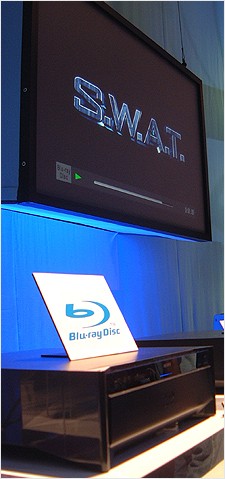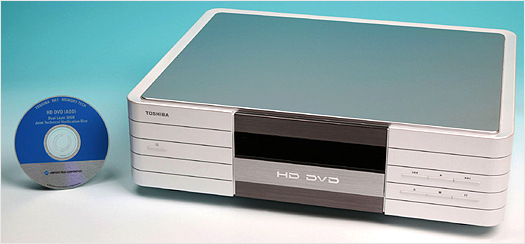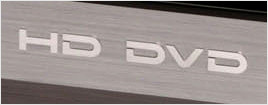 |
Site created 12/15/97.

page created: 1/12/04
Blu-ray Disc and HD-DVD:
The Bits at CES 2004
| Thursday,
January 8th, 2004 It's a beautiful, if smoggy, winter day in Las Vegas, Nevada. The air is warm enough to go without a jacket during the sunny hours, and most in attendance at the CES convention choose to do so, because it doesn't take long to work up a sweat moving from booth to booth, many standing room only, lugging an ever growing burden of product brochures, press releases and promo items. The 2004 Consumer Electronics Show is a vast and sprawling affair that dominates several different convention facilities in the city and draws in tens of thousands of people from all over the world. Centered in and around the Las Vegas Hilton and its attached Convention Center, CES is where the world's electronics manufacturers and other innovators come to show off the latest entertainment and convenience technologies, and to display prototypes of some of the state of the art products they plan to bring to market in the coming year. There's certainly plenty to see. Even if you were to walk the show for each of the four full days it runs, you'd never be able to take in everything. There are literally hundreds of booths and displays on hand, with sometimes dozens of interesting products and demonstrations to see in each. This year, the trend of convergence is more in evidence than ever. Everyone is showing some kind of "all in one" device that does seemingly everything you'd ever want it to. Satellite TV and radio services are everywhere - DirecTV, Xoom, Sirius, XM - each offering the promise of digital entertainment beamed to your computer, living room and even to portable, walk-around devices. Fancy having broadband Internet access in your car? It's on the way. There are more iPod like hand-held devices coming in 2004, each with massive and compact internal hard drives that can store your entire music collection (and possibly even your video collection too). And a few companies are touting integrated digital media boxes that are designed to act as the nerve center of your home's access to entertainment and information. Home theater technology seems to be advancing nicely as well. Walking from booth to booth, I can see many more, and ever larger, plasma and LCD flat-panel TVs on display than ever before. DLP is making greater in-roads in home theater projectors and rear projection sets. DTV, particularly high-definition HDTV, is being promoted even more enthusiastically than in previous years. I've been coming to CES nearly every year for a while now, usually to investigate the latest developments in DVD. Sure enough, there are plenty of new players to see, many with Firewire, HDMI (High Definition Multimedia Interface) and DVI outputs to allow the players to send digital audio and video signals more easily and cleanly to compatible receivers and TVs. Many of these new players can up-convert standard definition, 480p DVD video to 720p and even 1080i resolution for display on the latest HDTVs. 2004 also promises to be a big year for DVD recorders - there are many new models here that feature built-in TiVo or similar hard disc-based digital video recording capability. Love that latest episode of The West Wing you TiVo-ed last week? No problem - just burn it to DVD and add it to your library. Judging by the many players and features on display here, you'd never guess that just six years ago, many in this industry thought DVD would be little more than a niche product. This year, however, it's not DVD that I'm interested in. Instead, I've made the four-hour trek from the Bits' offices in Orange County, California to get my first look at the technologies that will one day replace our favorite home video format. There are two competing formats being promoted at CES this year - Blu-ray Disc and HD-DVD. |
||
|
||
| Thursday,
January 8th was a big day for the Blu-ray Group at CES - the first
U.S. press conference to promote the format was held here. The
invitation-only event was packed wall to wall with media and
representatives of the various group members. I'll tell you that I
haven't seen so many suits in one place in my life. As the media
filed into the room, the entire back wall of the conference room was
lined with anxious Japanese executives and engineers. Also in
attendance were Kuni Ando (President and Group COO of Sony), Frans
van Houten (CEO of Royal Philips Consumer Electronics Business
Groups) and Ben Feingold (President of Columbia TriStar Home
Entertainment), who were among the many people who spoke to the
audience during the presentation. The big announcement of the event was impressive indeed - the Blu-ray Group has earned the support of the two biggest PC manufacturers in the world, Dell and HP. Representatives of both companies were on hand to endorse Blu-ray Disc as "the most consumer-friendly technology choice for the next generation of removable storage." The Group also announced the online release of a White Paper describing the physical, logical and application specs of the format, and also some of the key enabling technologies (for further reading, you can find that on the Internet at this link). Let me describe the nuts and bolts of what was discussed at the press conference - the stuff that is most important from a home theater standpoint. The presentation started with a listing of some of the latest DVD industry trends and statistics. As of the end of 2003, DVD is now installed in between 55 and 70% of U.S. households, with some 73-80 million DVD drives in the market (that includes DVD-ROM drives and combo players as well as stand-alone set-top units). Over 2 billion discs have been sold to consumers. DVD recording capability is expected to be in 40% of U.S. households by 2008. The Blu-ray Group acknowledges that those numbers represent an amazing success story for DVD. But they note that because of the speed with which DVD has been adopted here in the States, the industry expects hardware sales for the format to peak between 2005 and 2007, and then slowly drop off. Even more significantly, by 2007 nearly 50% of U.S. households are expected to have high-definition capable Digital TVs. So starting between 2005 and 2007, more and more people will want to watch movies in high-definition on their new TVs. The Blu-ray Group intends to have their format ready for that timeframe. Blu-Ray Disc uses a blue laser to read the data contained on the disc, allowing that data to be packed much more tightly onto the disc's surface. Blu-ray Discs will come in three basic configurations. BD-ROM discs will accommodate pre-recorded packaged media (in other words, movies and other entertainment). BD-R discs are recordable. BD-RE discs are rewritable. The discs are exactly the same size as current DVD discs. Currently, BD-R and BD-RE discs require a cartridge to protect the media, because the format's smaller physical data read/write size on the disc makes it much more vulnerable to dust and scratches on the disc's surface. On this issue, however, I learned some very interesting things from a Japanese engineer with Sony. The Blu-ray Group is working to overcome a few technological difficulties, but the hope is that eventually recordable Blu-ray Disc media (BD-R and BD-RE) will not require the cartridge. Even more interestingly, I learned that BD-ROM media already does not require a cartridge. What that means to you is that pre-recorded movies on Blu-ray Disc format will look and feel virtually identical to current DVD discs, and can be packaged in the same way. Just pop the disc out of the case and slip it into your Blu-ray player's tray. In addition, BD-ROM discs come in two configurations, both single-sided. You can have a single-layered BD-ROM disc capable of storing 25 GB of data, or a dual-layered BD-ROM disc which holds 50 GB of data. The format also allows for the same kind of "on the fly" layer switching as current DVD, for the playback of longer movies. What this means for you, is that a single-layered BD-ROM disc can contain 135 minutes of high-definition movie data, along with 3 languages of Dolby Digital surround audio and 3 hours of bonus, standard-definition video content, OR it can contain 135 minutes of high-definition movie data, along with 3 languages of audio in Dolby Digital, DTS and PCM, and 70 minutes of bonus, standard-definition video content. That's enough room to contain most Hollywood movies, plus a documentary. But for longer films, there's dual-layered BD-ROM (using a layer switch). A dual-layered BD-ROM disc can contain 3 hours of high-definition movie data, along with 3 languages of Dolby Digital audio and 9 hours of bonus, standard-definition video content, OR 3 hours of high-def movie data, 3 languages of audio in Dolby Digital, DTS and PCM, plus 2 hours of bonus, high-definition video material. In other words, there's a configuration that allows Blu-ray Disc to contain virtually any Hollywood film, plus bonus material, all on a single disc. Adding a second disc to a release would then give you the room to produce a huge amount of additional bonus content - literally hours and hours of it in either standard or high-definition video. Imagine a 3 or 4 disc Blu-ray release of the ENTIRE Lord of the Rings trilogy in high-definition, with tons of extras. That's just one example of the many possibilities that BD-ROM promises to offer Hollywood and consumers. To ease the fears of content owners, Blu-ray Disc also allows very robust digital copy protection measures, including 128 bit encryption, hardware and software based "keys" which allow for control of content access, and "physical hooks" which allow the content to be "bound" to the media itself. You should also know that the format is designed to be a high-definition video recording format right off the bat, although there are still many copyright issues to be dealt with. The Blu-ray Disc spec allows backwards compatibility with existing optical disc formats, like current CD and DVD (this will be implemented by the individual hardware manufacturers), so no worries about your existing library becoming obsolete. The format includes the potential for much greater interactivity in terms of menus and other content access interfaces - the kind of interactivity that Nuon tried to add to standard DVD. Finally, the Blu-ray Disc spec allows for the current trend in convergence, meaning that Blu-ray Disc players can contain broadband modems and other connectivity options. Columbia TriStar's Ben Feingold told the gathering that Blu-ray Disc is being positioned for launch in the U.S. in 2005 or 2006, and that it will be supported by prepackaged high-definition movies from the studio. Another speaker told the crowd that replication costs will not be as expensive as some in the industry have predicted, because much of the existing production infrastructure can be retooled and reused for Blu-ray Disc. Costs for producing Blu-ray Disc are expected to eventually be within 10% of DVD-9 replication once economies of scale come into play. Phillips CEO Fran van Houten closed by extolling Blu-ray Disc as a truly innovative new format, rather than an incremental improvement on an existing product (he was obviously referring to HD-DVD here). He also said Blu-ray Disc provided the best protections against digital piracy, has all the "wow" factor consumers are going to expect, and the Blu-ray Discs will be the perfect optical media to bridge the PC and consumer electronics industries. For those of you who are interested, you can read more at the Blu-ray Disc official website. |
||
|
||
| I
will tell you that while Blu-ray Disc looked great, this prototype
display was definitely not representative of what final movie
product will look like to consumers. Each disc held only about 20
minutes worth of video, so you can bet that the video bit rate was
maxed throughout the presentation. There also seemed to be no menu
interface on this disc. Still, it was impressive proof that the
technology can and will work well for home theater purposes. |
||
 Sample Blu-ray Disc media used for the demo - BD-R (left) and BD-ROM (right). 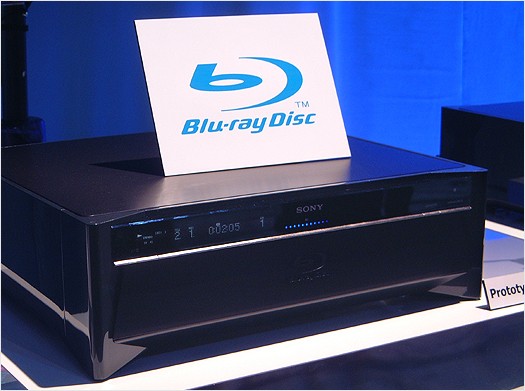 One of the two prototype Sony Blu-ray Disc players on display at CES. 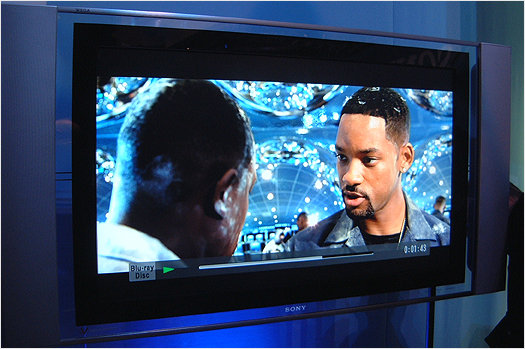 Blu-ray HD video as seen on Sony's new 42-inch KDL-42XBR950 WEGA LCD HDTV. |
||
| Now
let's talk about Toshiba and NEC's HD-DVD. I wish I could tell you
that HD-DVD made a good showing at CES, but there were no press
conferences and no presentations to the media. In fact, Toshiba made
only one real announcement with regard to the format, namely that
the company has developed a prototype HD-DVD player that uses a
single-lens optical head mechanism which integrates both blue and
red laser diodes. Translated, that means they've developed a player
that can play both standard-definition DVD and high-definition
HD-DVD discs, using a single optical head. That's certainly good
news because it means the hardware is compact and more economical to
manufacture, meaning cheaper prices for consumers. This prototype
player was on display in the Toshiba booth (more on that in a
minute). First, let me give you some format details for HD-DVD compared to Blu-ray Disc. Both HD-DVD and Blu-ray Disc use a 12 cm diameter disc that's 1.2 mm thick. Both use blue laser diodes to read data that is more tightly packed onto the disc's surface. Industry experts I spoke with at CES once again confirmed that both HD-DVD and Blu-Ray Disc hardware will be backwards compatible with existing CD and DVD formats (this will be a decision of each individual player manufacturer, but it seems likely to be almost universal). But here's where the difference lies. While BD-ROM discs can contain 25GB (single-layered) and 50GB (dual-layered) of data, HD-DVD-ROM discs are designed to hold only 15GB (single-layered) and 30GB (dual-layered). That presumably means that high-definition video is going to have to be more highly compressed on an HD-DVD disc to hold the same amount of content (in minutes) as a Blu-ray Disc (or the content will have to be spread over more discs or sides in HD-DVD format). In Toshiba's single-lens optical head press release, the company notes that HD-DVD is "also PC-friendly, as it does not need a cartridge - an essential feature for slim drives." But Blu-ray Disc is clearly working to make the cartridge unnecessary for recording, and has already done this for play-only ROM discs (the latter being of greatest concern to home theater enthusiasts). In our recently released book, The Digital Bits: Insider's Guide to DVD, Todd and I picked Blu-ray Disc as having the edge in the race to capture the next generation optical disc market. After what I've seen at CES, I'm even more convinced of this than ever. What's more, I think that edge is widening. The next generation optical disc format may still be at least 2 or 3 years away for consumers, but I'll tell you, the Blu-ray Group really seems to have its act together. If HD-DVD is going to make any kind of impact, and have a chance to really compete with Blu-ray Disc, Toshiba really needs to start moving and shaking soon. As I mentioned a moment ago, Toshiba also had a couple of prototype HD-DVD players on display in their booth on the show floor, but they weren't exactly going out of their way to promote the format. I actually walked through the booth and looked briefly at the display without even realizing I was looking at HD-DVD! It was only later, after talking with a friend at the Digital Entertainment Group meeting, that I realized what I'd seen. It almost seemed as if the whole purpose of having the players on hand was to provide good looking images to show off their thin-panel TVs. HD-DVD was definitely not the focus of attention, which was a shame. I will tell you that the high-definition video looked great, but as with the Blu-ray Disc demo, it's safe to say that this early demonstration wasn't representative of the kind of high-def product on disc that consumers will eventually be able to buy in their local Best Buy. I would be willing to bet that later in 2004 or early in 2005, as the corporate publicity engines start kicking into high gear for product debut, those of us in the media will get to start seeing actual high-definition movie content on both of these formats, with full menus and the like. In any case, as you may have guessed, I didn't take photos of the HD-DVD players in the Toshiba booth. I did, however, pick up a Toshiba product catalog which came with a photo of the prototype HD-DVD player and a 30GB dual-layered HD-DVD disc. You'll notice that the player features a new HD-DVD logo on its faceplate, but we have no idea if this is representative of the final logo for the format. |
||
|
||
So that's the latest news with HD-DVD at CES... what there was to report anyway. I'd like to tell you that the HD-DVD people have an official website for information on the format, but they don't. Still, you can find some information at the DVD Forum's website, as well as Toshiba's website. After checking out all of the new technology at CES, I headed over to the Bellagio Hotel to attend the Digital Entertainment Group's annual DVD State of the Industry reception. You may remember the DEG in one of its former incarnations as the DVD Video Group and DVD Entertainment Group respectively. The reception was packed with the usual Hollywood studio personnel and consumer electronics manufacturing executives, including the acknowledged "godfather" of DVD, Warren Lieberfarb (now on the board of directors with Sirius and Chairman of Lieberfarb & Associates). There's really not a lot of news to report from the meeting, but there are plenty of interesting statistics to mention with regard to DVD. As we mentioned earlier, the 2 billionth DVD software unit was shipped in 2003. Considering that the 1 billionth unit shipped in 2002, you get a sense of the blistering pace of sales for the format and the decidedly upward trend of the format's growth. More than 381 million discs were shipped to retail in the 4th quarter alone, bringing the total number of discs shipped since the format's launch to 2.4 billion. Consumers spent a record $22.5 billion renting and buying DVDs in 2003, versus the $9.2 billion spent on movie tickets. Home video spending was up some 18.2 percent over 2002, with DVD representing 72 percent of all purchases. 28 different DVD movie titles sold in excess of 5 million copies last year, led by Disney's Finding Nemo (with more than 20 million copies sold). And more than 34 million DVD players were sold in 2003 (we expect to have the final sales numbers soon). The DEG estimates that at least 30 million more will be sold in 2004, which would mean that 2 out of every 3 households in the U.S. will have at least one DVD player by the end of the year. In other news, the DEG officially announced that it's going to refocus its efforts beyond DVD in 2004 (thus the name change), to ensure that the Hollywood studios have a more powerful advisory lobby in the development of new formats (read: Blu-ray Disc and HD-DVD). It's worth nothing that the DEG is the only industry trade group that combines both hardware and software manufacturers in such close partnership. Finally, the DEG also announced the winners of its first Creative Excellence Awards (I was one of several industry insiders who participated in the nomination/selection process for the awards). The winners are as follows: Best Theatrical DVD Title of the Year The Lord of the Rings: The Two Towers Special Extended DVD Version (New Line) Best Non-Theatrical DVD Title of the Year (TIE) Steven Spielberg Presents: Taken (DreamWorks) The Dick Van Dyke Show: Season One (Image) Best Music on DVD Title of the Year Led Zeppelin DVD (Atlantic Records) Best Retailer of the Year Ultimate Electronics For more information on the Digital Entertainment Group, be sure to visit their official website. So that's our look at the latest next-generation format developments at the 2004 Consumer Electronics Show. You can bet we'll be watching the progress of both Blu-ray Disc and HD-DVD very closely in the year ahead, so stay tuned to The Digital Bits for the latest news updates. Hope you've enjoyed the report! Bill Hunt billhunt@thedigitalbits.com |
 |
| Site
designed for 1024 x 768 resolution, using 16M colors and .gif 89a
animation. © 1997-2015 The Digital Bits, Inc., All Rights Reserved. billhunt@thedigitalbits.com |

